De Fokkers F100 en F70 hoeven we vast en zeker niet te beschrijven behalve dat …………………………….. ze op final zijn? Volgens de laatste info op FSExpo zijn ze zeer waarschijnlijk binnenkort aan onze MSFS en MSFS2024 vloot toe te voegen. Eerst zal de F100 uitkomen en kort daarna zal ook de F70 landen, hierna zullen ze ook samen verkrijgbaar zijn in een pakket met korting. Op dit moment zijn de prijzen nog onbekend. Hier de laatste update veel kijk en leesplezier gewenst en een FIJN WEEKEND ALLEMAAL!
03 July 2025
It’s time for a new F70 Professional and F100 Professional in-development update!
Since our last update, the team has been working around the clock to elevate both products to an entirely new level. We’ve been pushing boundaries, refining every detail, and setting a new benchmark for what Just Flight products can deliver. While this unwavering focus on development has meant fewer in-development updates than usual, we’re confident that what’s coming will more than justify the wait.
To give you a meaningful look at the products, we’re taking you along on a test flight from Salzburg to Brussels in the latest Beta build of the F100 Professional. Please note that this is still a work-in-progress, so some bugs and unfinished elements are expected – and we’ll even highlight a few along the way!
Upon loading into the aircraft, the first thing that stands out is the modelling and texturing. It’s certainly a very different visual to the analogue cockpits we are used to developing, but the mix of the curved CRT displays and analogue standby instruments, really scratches that itch of a quirky, 90s airliner at the beginning of the ‘Glass Cockpit’ revolution. The cockpit textures have been created using extensive reference photograph of the real aircraft, and include some customisable elements such as different taxi light configurations, and various panel and instrument differences between the F70 and F100.
The exterior textures have also been created using extensive photography of the real aircraft, with every rivet, screw and panel line painstakingly hand placed. The exterior looks particularly impressive in MSFS 2024’s walkaround mode!
The cabin is also an area that has been meticulously crafted, and just like the exterior, includes several different configurations for the F100. Different cargo and passenger door options are modelled on the exterior and interior, and are automatically assigned based on the chosen livery. The cabin modelling and texturing are complete now on both the F70 and F100, with some of the remaining work including the fine tuning of the cabin lighting, and integrating the various cabin to cockpit interactions.
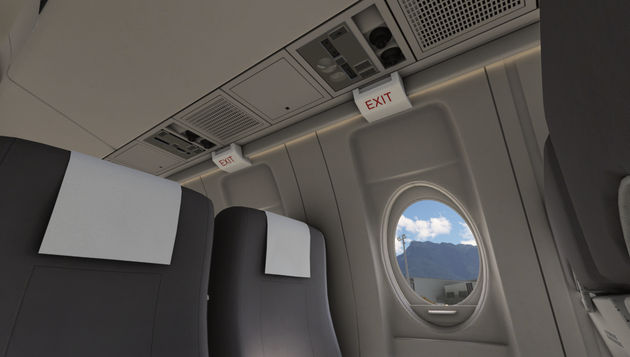
One area that has been a key focus for us during development is FPS/Performance. The optimisation process is still ongoing, but with our latest F100 Professional Beta build, we are seeing FPS figures that are within approximately 5% of the MSFS 2020 default 747 and 787. Of course FPS figures will vary from user to user, and will depend on PC specifications, the simulator used and the location in the simulator, so we can’t guarantee that you will be seeing the same FPS on your PC, but we hope this gives you a positive insight into the work we have put into this area. We encourage content creators to highlight the FPS on their systems when they are given access to the product for an unbiased, third-party opinion.
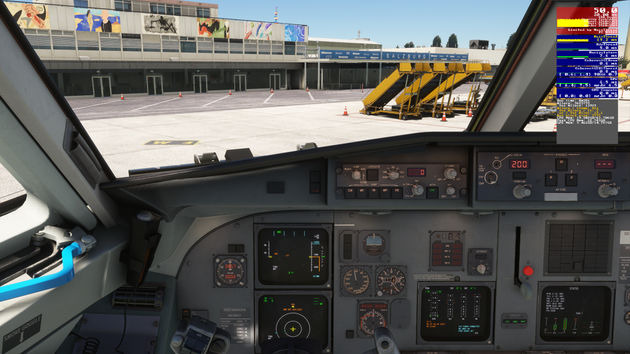
Once sat in the cockpit, electrical power can be applied to the aircraft and we can begin to work through the MSFS interactive checklists which house almost 300 individual items – over 250 of those items are to be completed prior to takeoff! Of course, most of these checklists are tests that are typically only carried out prior to the first flight of the day, but the checklists are all there and the associated systems logic will be included so that all of these checks can be completed in full. One remaining task on the system test front is the Annunciator Test, which involves a very specific, ordered illumination of all the cockpit annunciators. Fortunately, we have a slow motion video of this test recorded in the real aircraft, so we’ll be able to replicate this test with maximum accuracy.
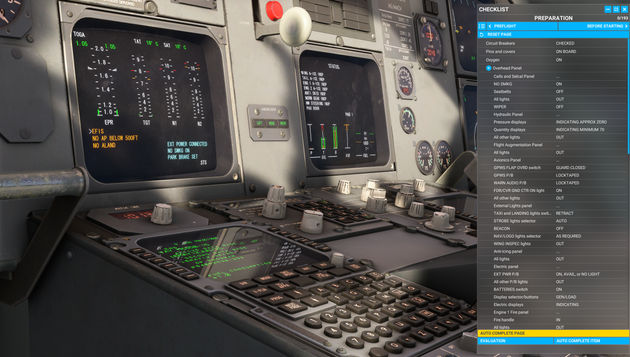
The Flight Management System (FMS) is complex, high-fidelity simulation in its own right. The FMS is entirely custom-coded and includes feature such as, IRS alignment (real time and fast align), manual IRS alignment adjustment, manual flight plan entry, automatic and manual navaid tuning, navigation and performance monitoring, custom waypoint creation, and Vertical Navigation (CLB, CRZ and DES). These are only just some of the features included with the FMS, and we’ll be sure dive deeper into these features in more depth in both the upcoming marketing content, as well as the Operations Manual.
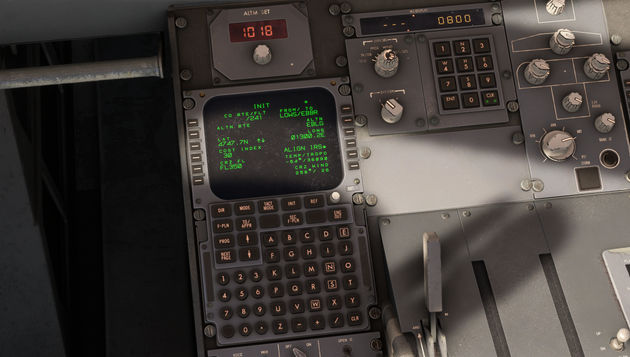
The FMS in the F70 and F100 is by far the most complex system we have ever developed for one of our aircraft. It’s the heart of the aircraft, with integration with the autopilot, flight model, EFIS displays and other systems. Due to this complexity, it’s naturally turned into the part of the aircraft that is taking the most time to develop, however, we do now consider the FMS to be feature complete, and our testing and development teams continue to, fine-tune, improve, and squash any remaining bugs ahead of the release.
Taxiing onto the runway, we get to perform something that we believe is unique to the F70 and F100 – Flaps 0 takeoffs. Although the aircraft can takeoff with Flaps 8 or Flaps 15, Flaps 0 is the standard takeoff flap setting that provides the best climb performance. The F70 and F100 have no slats, so with a Flaps 0 takeoff, the wing is in a fully clean configuration, with reliance placed on the aircraft’s thick wing and powerful engines.

Courtesy of the aircraft’s wing configuration, the aircraft has good performance at low altitudes, but will become sluggish at high altitudes, especially at higher weights and temperatures. As an example, if we take an F100 with Tay 620-15 engines operating at Maximum Takeoff Weight (MTOW) and taking off in ISA conditions from an airport at sea level, the aircraft should take 30 minutes and cover 156 nautical miles to reach 35,000ft. Based on recent tests in the simulator, we currently have the aircraft performing at 95% accuracy to these figures, which we are pleased with. Some phases of the climb profile are even closer to the elusive 100% accuracy, with other areas being closer to 95%, but this is one area of the product that continues to see improvements all the way up until release, so this accuracy will continue to improve.
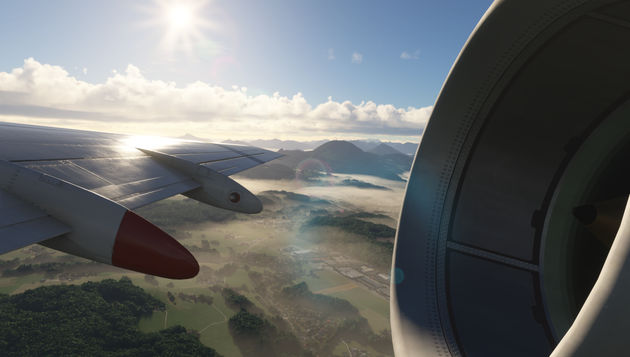
Climbing away from the mountainous backdrop, AP1, ATS, NAV and PROF modes are engaged on the FMP (Flight Mode Panel). AP1 is the master control for one of two Autopilot systems, ATS is the Autothrottle System which controls the throttles, NAV is the lateral navigation mode that ensure the aircraft follows the flight plan displayed on the Navigation Display, and PROF is the profile mode which is responsible for Vertical Navigation (VNAV). With these four modes engaged, they will work together to follow the lateral flight path as programmed in the FMS (and displayed on the Navigation Display), and will fly a vertical profile that respects any speed and altitude restrictions listed in the FMS.
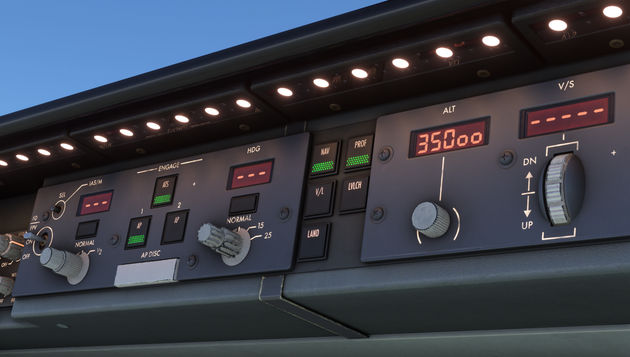
Whilst passing through 30,000ft, two alerts appear on the LH MFDU (Left-Hand Multi Functional Display Unit) indicating a high N1 speed in both engines. A checklist automatically opens on the RH MFDU (Right-Hand Multi Functional Display Unit) listing the necessary items that must be performed to rectify the issue. A cursor on the page can be cycled through each checklist item using an ADV (Advance) switch on the pedestal. Once a checklist has been completed, it will be automatically removed from the RH MFDU.
Whilst the engine N1 overspeeds aren’t an expected failure, they have proved a great opportunity to test the alerts, memo messages, and checklist system. From a testing perspective, feedback for this behaviour will now be written up and logged on our internal bug tracker for our development team investigate further. This will be good feedback for our development team, as the engine overspeeds were likely the result of some attempted improvements to the aircraft’s climb profile accuracy (as discussed earlier in this update). This is of course, is all a standard part of the development process, and the engine performance will be finalised ahead of the product’s release.
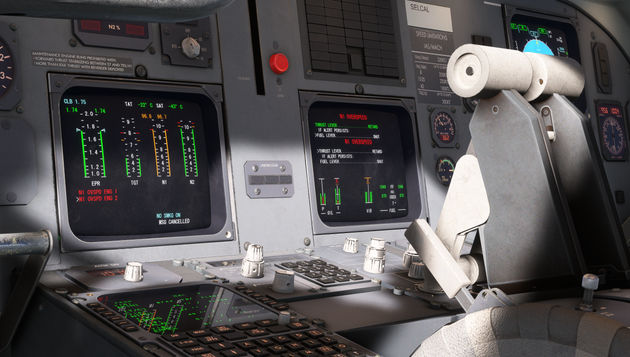
With the aircraft settled in the cruise, there usually isn’t much to do other than to listen to the sound of air rushing across the cockpit windows, and the engines and air conditioning working away in the background. Unfortunately, we can’t share sound through text and images, and although the sound set is actively in development, we aren’t at a point yet where we want to share it just yet. We will, however, have a Sound Overview video dedicated to the sound set ahead of the product’s release.
In case you missed it previously, you can read all about the sound recording session we had with the real aircraft last year
here When approaching the T/D (Top Of Descent) point as displayed on the Navigation Display, a descent can be started in one of several ways. The simplest way is to preselect a new altitude in the ALTITUDE window on the FMP and pull the altitude knob. That will arm “DES” (Descent) mode and upon reaching the T/D point, the aircraft will smoothly pitch down and follow the calculated descent profile down to the preselected altitude.
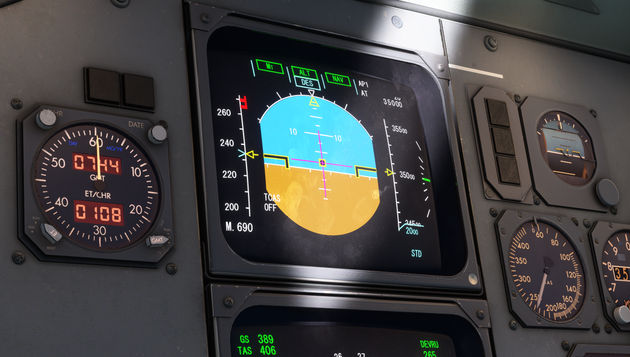
An alternative method of starting a descent is to use the IMM DES (Immediate Descent) feature through the FMS. Initially following the same procedure as previously listed to arm DES mode, an IMM DES option will become available in the top right field of the FMS F-PLN page. Pressing the LSK (Line Select Key) next to the IMM DES option will immediately start a descent at -1,000ft/min. Once in a descent, the IMM DES option will be replaced by a vertical speed field, where the pilot can change the required vertical speed. If during the descent the aircraft intercepts the standard descent profile, IMM DES will automatically disengage and the aircraft will then start to follow the standard decent profile. The IMM DES mode can be useful for both passenger comfort, or if an early, shallower descent is required.
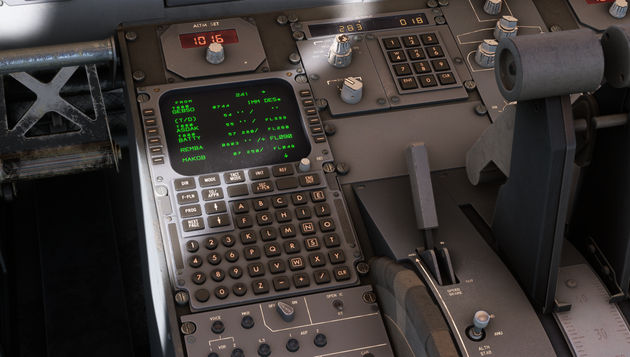
During the descent, multiple indications relating to the descent profile are present on the Navigation Display, such as the “T/D” marker, a “I/P” marker (Intercept Point) which shows the point where the aircraft will intercept the standard descent profile, and a vertical deviation scale on the right side of the display which indicates how high/low the aircraft is with respect to the standard descent profile. If at any point during the descent the pilot wants to regain some manual control of the aircraft, LVLCH (Level Change) and V/S (Vertical Speed) modes are also available.
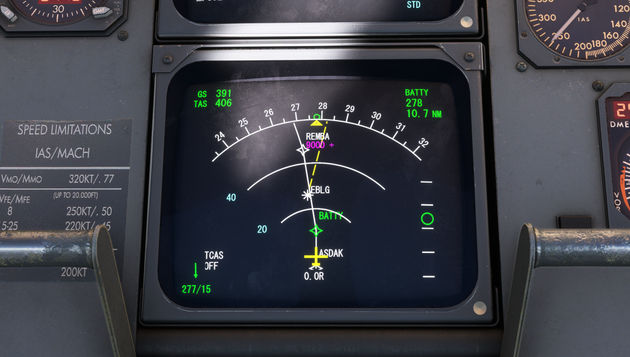
Upon approaching Brussel’s runway 01 with the VHF NAV radios tuned to the ILS frequency and course, the aircraft is now capable of an autoland. With LAND mode engaged and the aircraft in a landing configuration, a LAND 2 annunciator will display at the top of the PFD indicating that the autoland mode is enabled. With both Autopilots and the Autothrottle System all engaged, the pilots can sit back, put their feet up, and let the aircraft do the hard work itself…
Of course we jest, and we need to be extra vigilant when monitoring the instruments and the aircraft’s behaviour, especially whilst the aircraft is still in testing! We currently have the autoland system fully functional and an autoland is possible, but just like everything, we’re still fine-tuning certain aspects.
Upon landing, the lift-dumpers on the upper surface of the wings will deploy automatically, reverse thrust can be selected via levers on the throttles, and the autobrakes will slow the aircraft.
As that now concludes the test flight, all that was left to do was to taxi to the gate, shut down the aircraft, and log some feedback with our development team. A successful test flight isn’t just about smooth operation, it’s about confirming fixes and identifying areas for improvement. This flight met all our criteria and the feedback gathered from these test flights ensures that the product releases as polished as possible on day one.
We’re aware this update is text-heavy, but we hope it provided a valuable and engaging look into the progress we’ve made. The F70 Professional and F100 Professional represent our most ambitious projects to date, involving one of our largest development teams and a complex array of systems and features. We’re incredibly proud of how far we’ve come and are excited to share more soon. Thanks for reading!

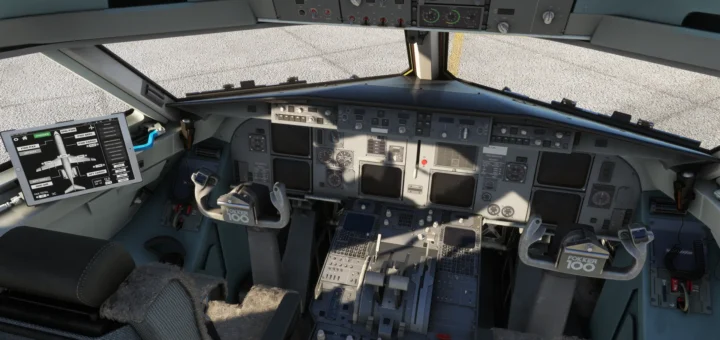
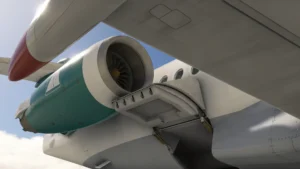
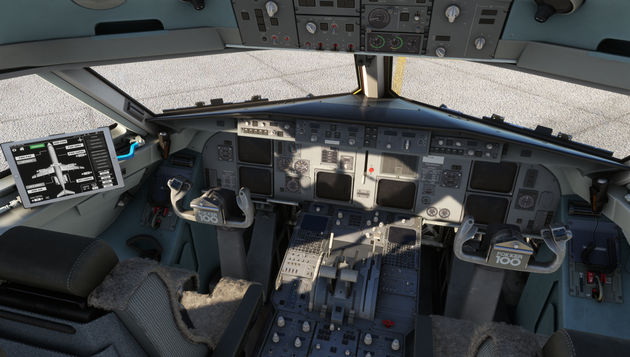





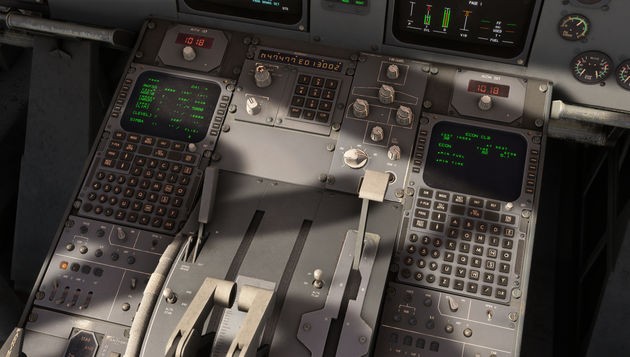




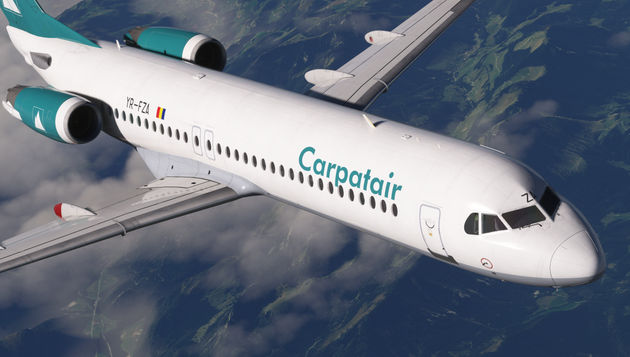




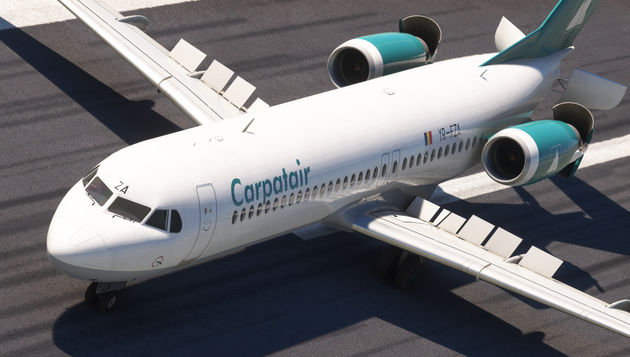


Zijn er overigens nog X-Plane vliegers onder onze lezers? Jazeker. Al jaren. Ik vind het een plezierige sim omdat er…
Gaaf zeg. Dank voor de tip.
De beta voor PS5 is live (als je je hebt opgegeven en geselecteerd bent! Kijk https://www.reddit.com/r/MicrosoftFlightSim/comments/1o1mxzx/got_my_msfs_2024_ps5_beta_access/
Inmiddels (3-10-2025) is er ook wat sound toegevoegd. https://orbxstudios.com/jwarchipelago/sound-update/
ja, dat klopt. In 2023 zijn de rechten weer teruggegaan naar Micropose. Kijk https://stormbirds.blog/2023/05/04/falcon-returns-to-microprose/ en ja de verse van BMS…
Als ik diep in mijn geheugen graaf schijnt er ook een samenwerking te zijn tussen Benchmark sims die de originele…